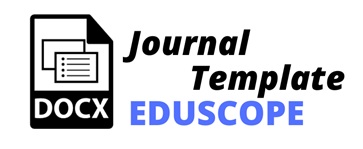PENERAPAN MODEL PEMBELAJARAN AUDITORY INTELLECTUALLY REPETITION (AIR) UNTUK MENINGKATKAN KEMAMPUAN PENALARAN DAN KOMUNIKASI MATEMATIK PESERTA DIDIK SMP
DOI:
https://doi.org/10.32764/eduscope.v8i1.2567Abstract
The purpose of this study is to describe the increase in the mathematical reasoning and communication skills of junior high school students by applying the auditory intellectually repetition (AIR) learning model. This research is a quasi-experimental research with a design pretest-posttest control group desaign. The population of this study were all students of class IX MTs Diponegoro in the 2021/2022 school year. The type of sample used in this study was random assignment. As for the research sample, two classes were selected, namely class IX A as the control class and class IX B as the experimental class.
The instruments used in this study were observation sheets and tests. The observation sheet was used to determine the suitability of learning in the classroom with Auditory Intellectually Repetition (AIR) learning model. The test instrument used in this study was a description question to measure students' mathematical reasoning and communication abilities. The data obtained were processed with two statistical data processing programs, namely SPSS and Microsoft Excel.
The results showed that the increase in the reasoning ability of the experimental class was in the medium classification and the control class was in the low classification. Meanwhile, for the improvement of mathematical communication skills, the experimental class is in the medium classification and the control class is in the low classification. So that the auditory intellectually repetition (AIR) learning model can improve students' mathematical reasoning and communication skills.
KEYWORDS: learning model Auditory Intellectually Repetition (AIR), mathematical reasoning skills, mathematical communication skills.
The purpose of this study is to describe the increase in the mathematical reasoning and communication skills of junior high school students by applying the auditory intellectually repetition (AIR) learning model. This research is a quasi-experimental research with a design pretest-posttest control group desaign. The population of this study were all students of class IX MTs Diponegoro in the 2021/2022 school year. The type of sample used in this study was random assignment. As for the research sample, two classes were selected, namely class IX A as the control class and class IX B as the experimental class.
The instruments used in this study were observation sheets and tests. The observation sheet was used to determine the suitability of learning in the classroom with Auditory Intellectually Repetition (AIR) learning model. The test instrument used in this study was a description question to measure students' mathematical reasoning and communication abilities. The data obtained were processed with two statistical data processing programs, namely SPSS and Microsoft Excel.
The results showed that the increase in the reasoning ability of the experimental class was in the medium classification and the control class was in the low classification. Meanwhile, for the improvement of mathematical communication skills, the experimental class is in the medium classification and the control class is in the low classification. So that the auditory intellectually repetition (AIR) learning model can improve students' mathematical reasoning and communication skills.
KEYWORDS: learning model Auditory Intellectually Repetition (AIR), mathematical reasoning skills, mathematical communication skills.









